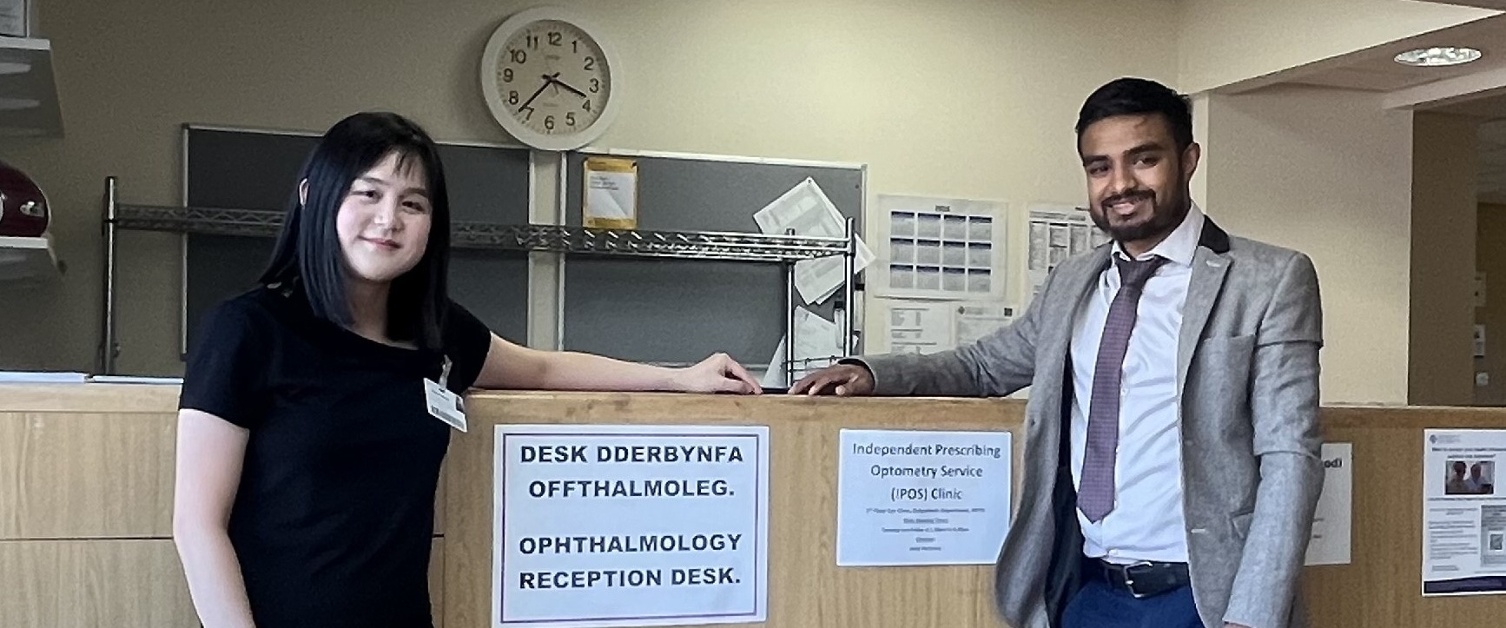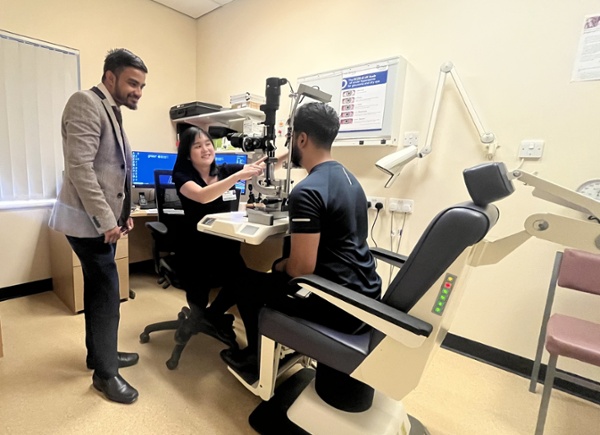New clinic helps to upskill students and improve access for patients

Optometrists are honing their skills and helping to reduce waiting times for patients as part of a new teaching facility in Neath Port Talbot.
The teach and treat clinic helps to train optometrists, who will be able to provide the independent prescribing service to patients in future.
Staff train qualified and registered optometrists who are studying for their independent prescribing qualification.
This allows optometrists to diagnose, manage and treat a range of eye conditions.
It means patients can often receive their care sooner and closer to home as it takes away the need for them to be referred to hospital.
Pictured: Senior hospital optometrist Kelly Pitchford and optometric advisor Mohammed Islam.
Students who come to the clinic, based at Neath Port Talbot Hospital, would have already completed theoretical examinations as part of their university course.
The teach and treat clinic forms part of their placement, where they can develop a portfolio to show how they have supported and treated patients.
Kelly Pitchford is the senior hospital optometrist who provides the training at the clinic.
She said: “All of these students have completed their theoretical examinations, and the next phase is to attend a placement where they need to complete 24 sessions.
“During the sessions, they gain practical knowledge and can build up a portfolio to show that they’ve seen the required number of patients.
“Once they have completed the practical element, they go back to university to complete the third phase of their training which is a final examination.
“If they qualify then they can apply to be able to prescribe in the community.”

Maisie Evans qualified as an optometrist from Cardiff University in 2019 and now works at Bater & Stout Opticians, in Morriston.
She has since received training at the teach and treat clinic as part of her postgraduate qualification.
“I found the training very informative and helpful in my independent prescribing journey,” she said.
“The training consisted of seeing and examining all patients alongside creating a management and treatment plan.
“It was good that all the patients we saw were screened so we were only seeing patients that we would actually see in a community setting.
“The most useful tool I took from the experience was knowing how to confidently write my own prescriptions, as this was something I was nervous about doing before I started.
“The clinic is an excellent way for independent prescribing students to learn and familiarise themselves with conditions they will be seeing in the community.
“This ultimately will encourage more optometrists to take part and help take the strain off hospital staff.”
The training clinic was introduced in the Neath Port Talbot area to help improve access to independent prescribers for patients living in the area.
“We have a growing number of independent prescribing optometrists in the community but many of them are based in the Swansea area,” Kelly added.
“We decided to set up the teaching clinic in Neath Port Talbot Hospital so patients have easier access to the service.
"The clinic was established in partnership with Cardiff University School of Optometry and Vision Sciences.
“The clinic has provided an additional location for patients in the area to be referred to.
“We are also hoping once the students graduate, it will help to generate more interest in the future for them to practice in the Neath Port Talbot area.”
Being able to manage more patients in the community is not only of benefit to them, but also to the hospital-based consultants who can spend their time seeing other patients.
Mohammed Islam, optometric advisor for the health board, said: “This is helping to bring more services into the community for patients.
“We are helping patients to be seen closer to home instead of having to go to Singleton Hospital for emergency eye care.
“The clinic is going to help with upskilling the profession and providing services to help reduce the backlog of people waiting to be seen.”
Rydym yn croesawu gohebiaeth a galwadau ffôn yn y Gymraeg neu'r Saesneg. Atebir gohebiaeth Gymraeg yn y Gymraeg, ac ni fydd hyn yn arwain at oedi. Mae’r dudalen hon ar gael yn Gymraeg drwy bwyso’r botwm ar y dde ar frig y dudalen.
We welcome correspondence and telephone calls in Welsh or English. Welsh language correspondence will be replied to in Welsh, and this will not lead to a delay. This page is available in Welsh by clicking ‘Cymraeg’ at the top right of this page.